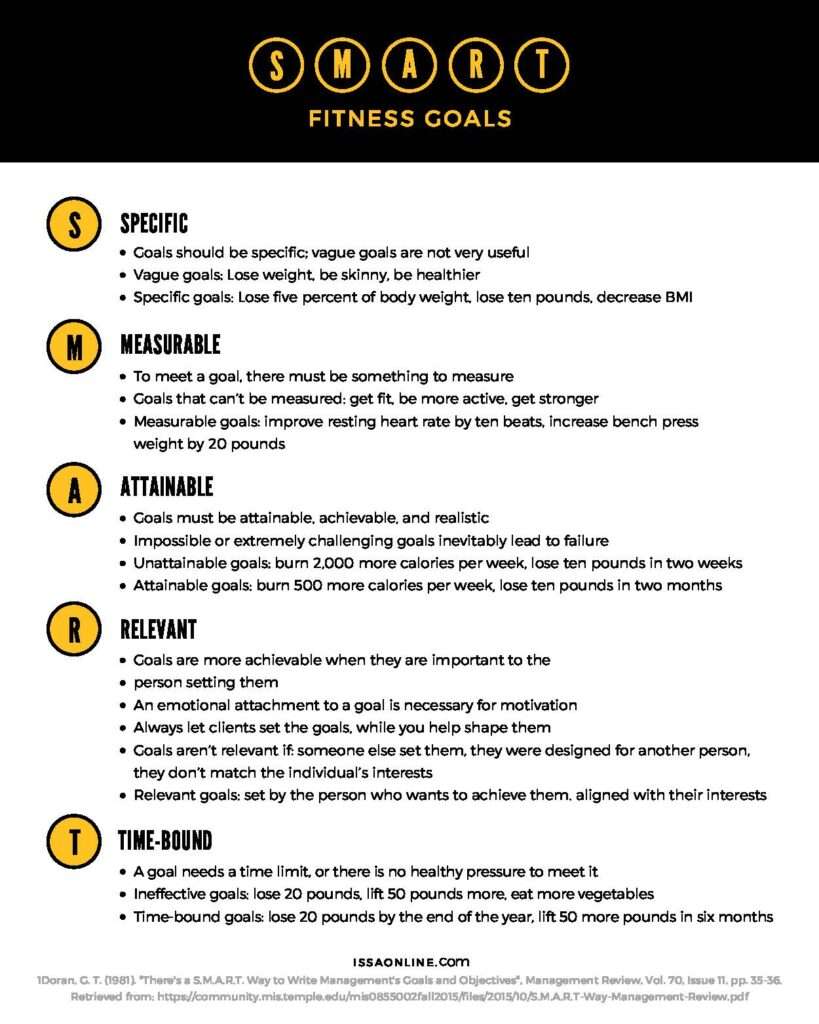Are you tired of setting fitness goals that seem impossible to achieve? Look no further! With the new product, “How Do I Set Realistic Fitness Goals”, you will discover the secret to creating achievable and meaningful fitness targets. This guide is designed to help you understand the importance of setting realistic goals, provide practical tips to set them effectively, and offer motivation to keep you on track. Transform your fitness journey and say goodbye to unrealistic expectations with this must-have product!

Define Your Fitness Goals
When it comes to setting fitness goals, the first step is to define them clearly. Ask yourself why you want to achieve these goals and what you hope to accomplish. Do you want to lose weight, gain muscle, improve flexibility, increase endurance, or enhance overall fitness? By understanding your motivations, you can set goals that truly resonate with you and keep you motivated.
Identify the Specific Outcome You Want
To ensure your goals are actionable, it’s important to be specific about the outcome you desire. For example, rather than saying “I want to lose weight,” specify how much weight you want to lose and in what timeframe. By setting specific targets, you’ll have a clear vision of what you’re working towards and be able to track your progress more effectively.

Consider Your Current Fitness Level
To set realistic goals, it’s essential to consider your current fitness level. Take some time to assess your strengths, weaknesses, and any physical limitations you may have. This will help you tailor your goals to your individual needs and abilities. Remember, every fitness journey is unique, and acknowledging where you’re starting from is crucial for long-term success.
Break Your Goals into Short-term and Long-term Objectives
Breaking your goals into short-term and long-term objectives can make them more manageable and achievable. Short-term goals can be accomplished within weeks or months, while long-term goals may take several months or even years. By dividing your goals into smaller milestones, you’ll be able to track your progress more effectively and stay motivated along the way.

Make Your Goals SMART
When setting fitness goals, following the SMART framework can significantly increase your chances of achieving them:
Specific
Be specific about what you want to achieve. Avoid vague or general statements and define your goals in clear and concise terms.
Measurable
Ensure your goals are measurable so that you can track your progress objectively. Use quantifiable metrics such as weight, body measurements, or fitness tests to gauge your success.
Achievable
Set goals that are realistic and attainable based on your current fitness level, resources, and commitment. It’s essential to challenge yourself, but setting unrealistic goals can lead to frustration and demotivation.
Relevant
Make sure your goals align with your overall health and wellness objectives. They should be relevant to your personal values and aspirations.
Time-bound
Set a specific timeframe for achieving your goals. A deadline can provide motivation and help you stay focused on making progress within a certain period.
Assess Your Availability and Commitment
Consider your availability and commitment level before setting fitness goals. Evaluate how much time you can dedicate to your fitness routine and whether you’re willing to make any necessary lifestyle changes. This assessment will help you set goals that are realistic and in line with your daily schedule and personal commitments.
Evaluate Your Time Constraints
Take an honest look at your schedule and determine how much time you can realistically devote to exercise and physical activity. Consider your work obligations, family responsibilities, and other commitments. By understanding your time constraints, you can set goals that are feasible within your current lifestyle.
Consider Your Level of Dedication
Assess your level of dedication and willingness to put in the effort required to achieve your fitness goals. Setting ambitious goals requires a certain level of commitment, discipline, and consistency. Ask yourself if you’re willing to prioritize your fitness journey and make it a priority in your life.
Determine Your Willingness to Make Lifestyle Changes
Achieving significant fitness goals often requires making lifestyle changes. Assess your willingness to adopt healthier habits, such as adjusting your diet, getting sufficient sleep, and managing stress. Being honest with yourself about your readiness to embrace change will enable you to set goals that are in line with your willingness to make adjustments.

Take Your Physical Abilities and Limitations into Account
Before setting fitness goals, it’s crucial to consider your physical abilities and limitations. Understanding your body’s strengths and weaknesses can help you set appropriate goals that are tailored to your individual needs.
Consider Your Health and Fitness History
Reflect on your health and fitness history, including any past injuries or medical conditions. Knowing your limitations and any precautions you should take can help you set realistic and safe goals. Consult with a healthcare professional if necessary to ensure that your fitness goals align with your overall health and well-being.
Assess Your Strengths and Weaknesses
Identify your physical strengths and weaknesses to set goals that challenge you but are within your capabilities. If you excel in cardiovascular endurance but struggle with strength training, for example, you may set goals that prioritize building strength while still maintaining your cardiovascular fitness.
Consult with a Healthcare Professional if Necessary
If you have any concerns or questions about your physical abilities or limitations, it’s always a good idea to consult with a healthcare professional. They can provide personalized advice and guidance based on your specific circumstances, helping you set goals that are safe, effective, and aligned with your overall health.
Set Realistic Targets Based on Healthy Guidelines
When setting fitness goals, it’s essential to prioritize your health and well-being over appearance or societal expectations. By following healthy guidelines, you can set realistic targets that promote overall well-being and long-term success.
Prioritize Health Over Appearance
Focusing on health rather than appearance can help you set goals that are sustainable and beneficial for your body. Instead of obsessing over a specific number on the scale or achieving a particular body shape, aim for improvements in energy levels, strength, stamina, and overall physical and mental health.
Set Realistic Weight Loss or Gain Goals
If weight management is one of your goals, set realistic targets based on a healthy rate of weight loss or gain. Rapid weight loss can be detrimental to your health, so aim for a steady, sustainable approach. Consult with a healthcare professional or nutritionist for guidance on setting healthy weight-related goals.
Focus on Improved Body Composition
Instead of solely focusing on weight, consider aiming for improved body composition. This means increasing lean muscle mass while reducing body fat percentage. This can lead to a healthier, more toned physique and improved overall fitness.
Consider Setting Performance-based Goals
In addition to appearance-related goals, consider setting performance-based goals. Whether it’s running a certain distance, lifting a specific weight, or mastering a new yoga pose, focusing on performance-oriented goals can enhance motivation and provide a sense of accomplishment.

Break Down Your Goals into Actionable Steps
Once you have defined your fitness goals, it’s time to break them down into actionable steps. This will help you create a roadmap for success and provide a clear path to achieving your objectives.
Determine the Necessary Actions
Identify the specific actions you need to take to reach your goals. For example, if your goal is to run a marathon, you may need to start by increasing your mileage gradually, following a structured training plan, and incorporating strength and cross-training exercises.
Set Weekly or Monthly Milestones
Break your goals down further into weekly or monthly milestones. This allows you to track your progress more regularly and celebrate small wins along the way, keeping you motivated and engaged.
Identify Potential Obstacles and Plan to Overcome Them
Anticipate potential obstacles that may hinder your progress and develop strategies to overcome them. Whether it’s time constraints, lack of motivation, or external factors, having a plan in place will help you stay on track even when faced with challenges.
Track Your Progress Regularly
Regularly tracking your progress is crucial for staying motivated and making adjustments as needed. There are several ways to monitor your journey effectively:
Establish a Measuring System
Determine how you will measure and track your progress. Whether it’s weighing yourself, taking body measurements, or using fitness assessments, having a consistent measuring system will provide tangible data to gauge your progress.
Keep a Workout and Nutrition Journal
Maintaining a workout and nutrition journal can be highly beneficial for tracking your progress and identifying patterns or areas for improvement. Record your workouts, nutrition choices, and how you feel physically and mentally to gain insights into what works best for your body.
Use Apps or Fitness Trackers
Leverage technology by using fitness apps or trackers to monitor your workouts, nutrition, and progress. Many apps offer features such as goal tracking, workout plans, and even virtual communities for support and motivation.
Stay Accountable with a Workout Buddy or Coach
Having a workout buddy or working with a coach can significantly increase accountability and motivation. A partner or coach can provide support, guidance, and encouragement throughout your fitness journey, making it easier to stay on track and achieve your goals.
Adjust Your Goals and Plans as Needed
As you progress on your fitness journey, it’s essential to monitor your goals and plans regularly. Life circumstances, physical changes, and shifts in priorities can all impact your goals, so being flexible and open to adjustments is crucial for long-term success.
Monitor Your Progress and Recognize Adjustments
Regularly review your progress and evaluate if your goals are still aligned with your aspirations. Recognize when adjustments are necessary, whether it’s increasing the intensity of your workouts, modifying your nutrition plan, or reassessing your timeline. Being proactive in adapting to changing circumstances will help you stay on track and continue to make progress.
Be Flexible and Adapt to Changing Circumstances
Life is dynamic, and circumstances can change unexpectedly. Be willing to adjust your goals and plans as needed to accommodate unforeseen challenges or new opportunities. This flexibility will prevent you from feeling discouraged or overwhelmed and allow you to continue working towards your ultimate vision.
Reevaluate and Modify Your Goals Regularly
Set aside time regularly to reevaluate and modify your goals as needed. This could be done monthly, quarterly, or annually, depending on the nature of your objectives. By reassessing your goals, you can ensure they remain relevant and aligned with your evolving priorities and aspirations.
Celebrate and Reward Milestone Accomplishments
As you achieve milestones along your fitness journey, be sure to celebrate and reward yourself for your hard work and achievements. It’s important to acknowledge and appreciate the progress you’ve made, no matter how big or small.
Set Tangible and Meaningful Rewards
Establish rewards for yourself that are meaningful and reinforce positive behaviors. These rewards can be anything that brings you joy and supports your well-being, such as treating yourself to a massage, a new fitness gadget, or a day of rest and relaxation.
Acknowledge Your Hard Work and Achievements
Take time to recognize your hard work and the milestones you’ve accomplished. Pause and reflect on the progress you’ve made, the obstacles you’ve overcome, and the positive changes you’ve experienced. This acknowledgment will enhance your confidence and motivation to continue pushing towards your goals.
Don’t hesitate to share your achievements with others. Find a supportive community or social network where you can celebrate your victories and inspire others on their own fitness journeys. By sharing your success, you can both inspire and be inspired by others, creating a positive circle of motivation and support.
Maintain a Positive Mindset
Maintaining a positive mindset throughout your fitness journey is paramount. Here are some strategies to help you stay positive and motivated along the way:
Focus on the Journey, Not Just the Destination
While goals are essential, it’s crucial to enjoy the process and embrace the experience of working towards them. Celebrate small wins, find joy in each workout or healthy meal, and appreciate the growth and self-discovery that comes with your fitness journey.
Practice Self-Compassion and Patience
Be kind to yourself and practice self-compassion throughout your fitness journey. Embrace setbacks as learning opportunities, be patient with your progress, and treat yourself with understanding and forgiveness. Remember, it’s a marathon, not a sprint.
Surround Yourself with Supportive People
Surround yourself with supportive individuals who uplift and encourage you. Seek out fitness communities, workout buddies, or even a supportive friend or family member who can provide encouragement and accountability. Positive social connections can significantly impact your motivation and mindset.
Visualize Your Success
Visualize your success and imagine yourself achieving your fitness goals. Use the power of visualization to create a clear mental image of what you want to accomplish. This technique can boost motivation, enhance focus, and increase belief in your ability to succeed.
Setting realistic fitness goals is a journey of self-discovery and growth. By defining your goals, assessing your abilities and commitments, and creating actionable plans, you’ll set yourself up for success. Remember to track your progress, adjust when necessary, celebrate milestones, and maintain a positive mindset. With determination and consistency, you can achieve your fitness goals and embark on a lifelong journey of health and well-being.
